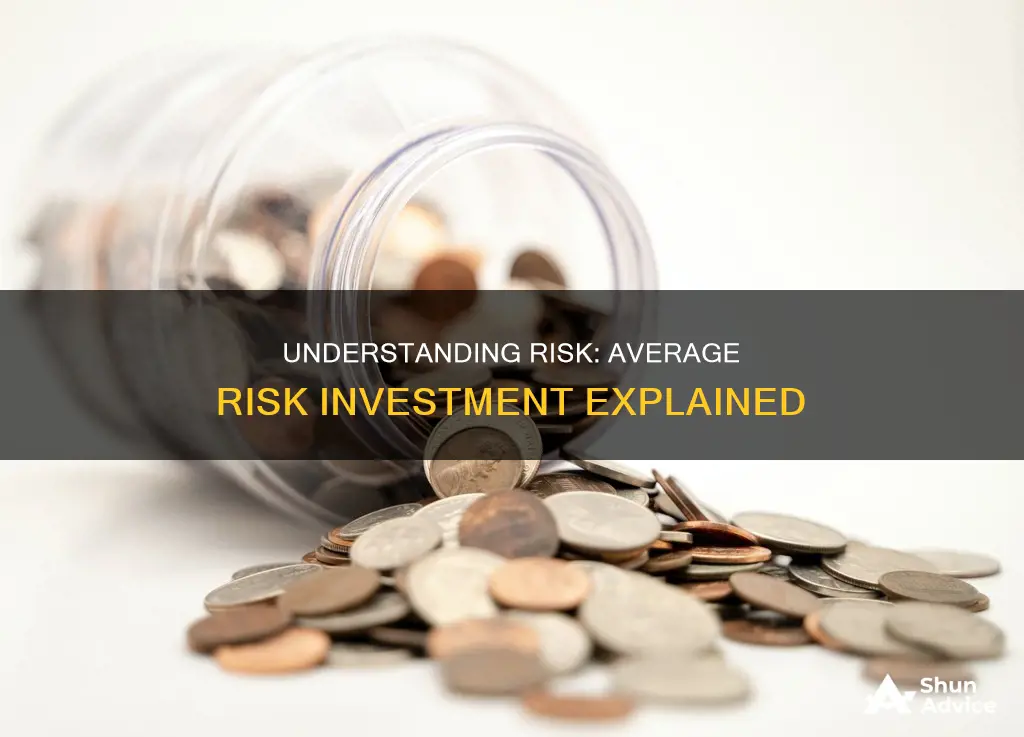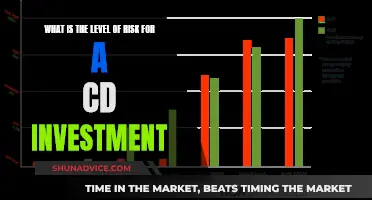
Risk is defined in financial terms as the chance that an investment's actual gains will differ from an expected outcome or return. In other words, risk is the possibility of losing some or all of an original investment. When it comes to investing, the higher the risk, the more you should receive for holding the investment, and the lower the risk, the less you should receive, on average. Stocks have historically provided a higher return than bonds and cash investments, but they also come with a higher level of risk. Medium-risk investments offer a stable return while still allowing for capital appreciation.
| Characteristics | Values |
|---|---|
| Definition | Risk is the chance that an investment's actual gains will differ from an expected outcome or return. |
| Risk-reward trade-off | The higher the risk, the more you should receive for holding the investment. |
| Historical performance | Stocks have enjoyed the most robust average annual returns over the long term (just over 10% per year), followed by corporate bonds (around 6% annually). |
| Volatility | Stocks have higher price volatility than bonds. |
| Capital appreciation | Medium-risk investments should offer a stable return while still allowing for capital appreciation. |
What You'll Learn
- Stocks vs bonds: stocks have higher price volatility but historically higher returns
- Risk-reward trade-off: higher risk should mean higher returns
- Medium-risk investments: stable returns with capital appreciation
- Risk measurement: standard deviation is a common metric
- Risk management: understand the basics of risk and how it's measured

Stocks vs bonds: stocks have higher price volatility but historically higher returns
Risk is defined in financial terms as the chance that an investment's actual gains will differ from the expected outcome or return. Risk includes the possibility of losing some or all of an original investment. In finance, standard deviation is a common metric associated with risk. It provides a measure of the volatility of asset prices in comparison to their historical averages in a given time frame.
The risk-reward trade-off is a general principle that underlies nearly anything from which a return can be generated. Anytime you invest money into something, there is a risk, whether large or small, that you might not get your money back. For bearing that risk, you expect a return that compensates you for potential losses. In theory, the higher the risk, the more you should receive for holding the investment, and the lower the risk, the less you should receive, on average.
Stocks have higher price volatility than bonds. This is because bonds afford certain protections and guarantees that stocks do not. For instance, creditors have greater bankruptcy protection than equity shareholders. Bonds also provide steady promises of interest payments and the return of principal even if the company is not profitable.
Historically, stocks have enjoyed the most robust average annual returns over the long term (just over 10% per year), followed by corporate bonds (around 6% annually), Treasury bonds (5.5% per year) and cash/cash equivalents such as short-term Treasury bills (3.5% per year). The trade-off is that with this higher return comes greater risk. And although stocks have historically provided a higher return than bonds and cash investments, it's not always the case that stocks outperform bonds or that bonds are always lower risk than stocks.
Hotel Investment in India: A Comprehensive Guide
You may want to see also

Risk-reward trade-off: higher risk should mean higher returns
Risk is defined in financial terms as the chance that an outcome or investment's actual gains will differ from an expected outcome or return. Risk includes the possibility of losing some or all of an original investment. In the context of investing, reward is the possibility of returns or profits.
The risk-reward trade-off is a general principle that underlies nearly anything from which a return can be generated. Anytime you invest money, there is a risk, however small, that you might not get your money back. For bearing that risk, you expect a return that compensates you for potential losses. In theory, the higher the risk, the more you should receive for holding the investment, and the lower the risk, the less you should receive, on average.
Stocks have historically enjoyed the most robust average annual returns over the long term (just over 10% per year), followed by corporate bonds (around 6% annually), Treasury bonds (5.5% per year) and cash/cash equivalents such as short-term Treasury bills (3.5% per year). The trade-off is that with this higher return comes greater risk. Although stocks have historically provided a higher return than bonds and cash investments, it's not always the case that stocks outperform bonds or that bonds are always lower risk than stocks.
The middle portion of a portfolio should be made up of medium-risk investments that offer a stable return while still allowing for capital appreciation. Although riskier than the assets creating the base, these investments should still be relatively safe. The summit of the portfolio is reserved specifically for high-risk investments and should consist of money you can lose without any serious repercussions.
Investing Wisely: The Importance of a Diverse Portfolio
You may want to see also

Medium-risk investments: stable returns with capital appreciation
Risk in financial terms is defined as the chance that an investment's actual gains will differ from an expected outcome or return. Risk includes the possibility of losing some or all of an original investment. In general, the higher the risk, the more you should receive for holding the investment, and the lower the risk, the less you should receive, on average.
Medium-risk investments offer a stable return while still allowing for capital appreciation. Although riskier than low-risk investments, these investments should still be relatively safe. Medium-risk investments make up the bulk of your assets.
Historically, stocks have enjoyed the most robust average annual returns over the long term (just over 10% per year), followed by corporate bonds (around 6% annually), Treasury bonds (5.5% per year) and cash/cash equivalents such as short-term Treasury bills (3.5% per year). The trade-off is that with this higher return comes greater risk. Although stocks have historically provided a higher return than bonds and cash investments, it's not always the case that stocks outperform bonds or that bonds are always lower risk than stocks. For example, bonds provide steady promises of interest payments and the return of principal even if the company is not profitable.
Beneficial Investments: Strategies for Smart Money Allocation
You may want to see also

Risk measurement: standard deviation is a common metric
Risk is defined in financial terms as the chance that an outcome or investment's actual gains will differ from an expected outcome or return. Risk includes the possibility of losing some or all of an original investment.
HNIs' Investment Strategies in India: Where Do They Invest?
You may want to see also

Risk management: understand the basics of risk and how it's measured
Risk is defined in financial terms as the chance that an investment's actual gains will differ from an expected outcome or return. Risk includes the possibility of losing some or all of an original investment. In other words, anytime you invest money, there is a risk, whether large or small, that you might not get your money back.
Risk-reward is a general trade-off underlying nearly anything from which a return can be generated. The higher the risk, the more you should receive for holding the investment, and the lower the risk, the less you should receive, on average. For example, stocks have enjoyed the most robust average annual returns over the long term (just over 10% per year), but they also come with a higher level of risk. Corporate bonds, meanwhile, have historically provided a lower return (around 6% annually) but are also lower risk than stocks.
When determining risk, it is useful to refer to the risk pyramid. The middle portion of the pyramid is made up of medium-risk investments that offer a stable return while still allowing for capital appreciation. These investments should be relatively safe, although they are riskier than the assets creating the base of the pyramid. The summit of the pyramid is reserved for high-risk investments and should consist of money that you can lose without any serious repercussions.
Quantifiably, risk is usually assessed by considering historical behaviours and outcomes. Standard deviation is a common metric associated with risk, providing a measure of the volatility of asset prices in comparison to their historical averages in a given time frame.
Invest in Apartments: India's Real Estate Guide
You may want to see also
Frequently asked questions
An average-risk investment is one that offers a stable return while still allowing for capital appreciation. It is riskier than the assets creating the base of your portfolio, but it should still be relatively safe.
Some examples of average-risk investments include corporate bonds and Treasury bonds. Corporate bonds have historically provided an average annual return of around 6%, while Treasury bonds have provided an average annual return of 5.5%.
Average risk is higher than low risk but lower than high risk. In general, the higher the risk, the more you should expect to receive for holding the investment, and the lower the risk, the less you should expect to receive.







